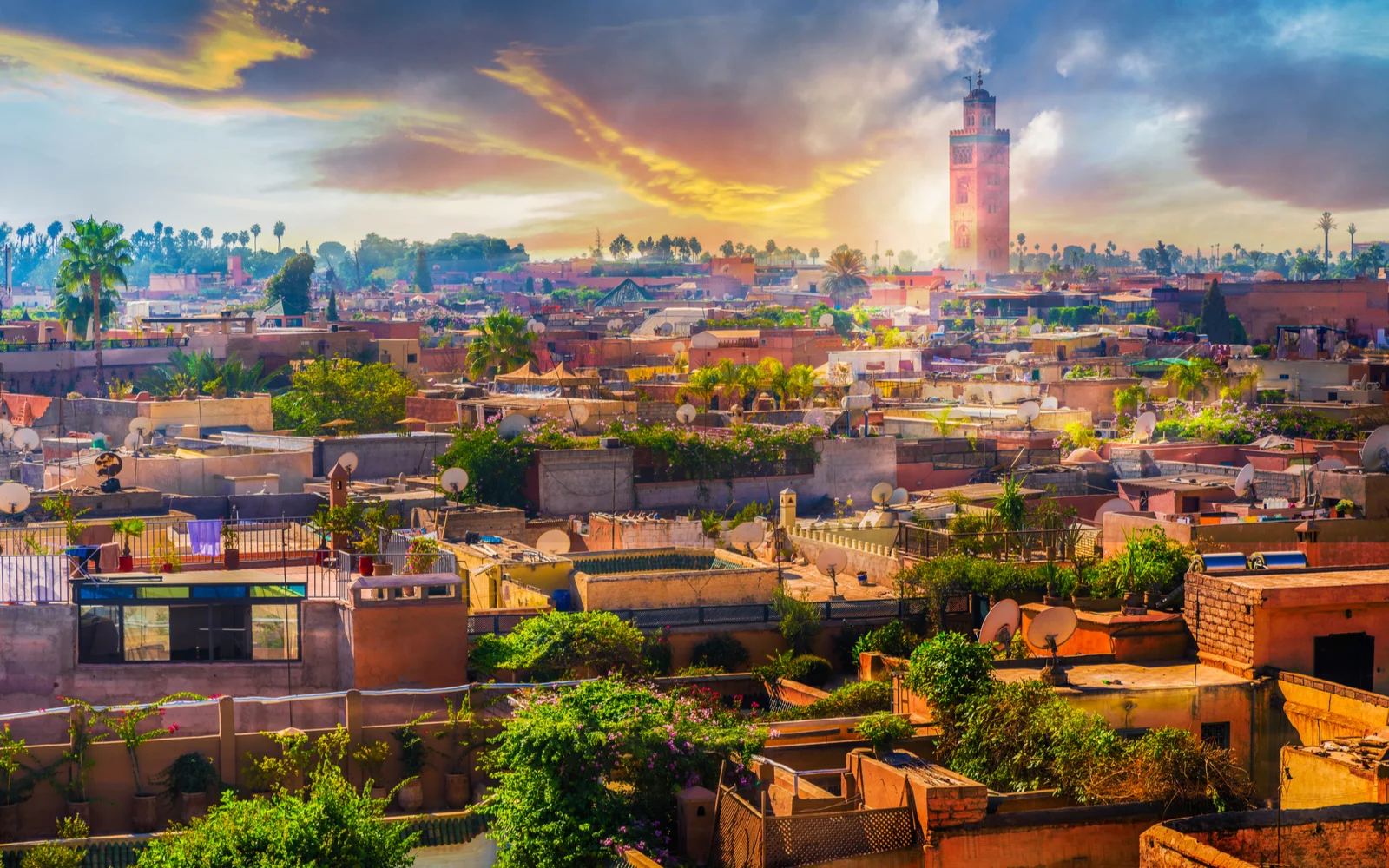What's the best time to visit Morocco?
The best time to visit Morocco is between mid-April and May and September to October. These months offer a reprieve from the summer heat with mild weather ranging from the 60s in the mountains and coasts to the 90s in desert regions and Marrakech. It’s an excellent time for sightseeing, attending cultural festivals, and enjoying beaches and outdoor activities around the country.
Morocco is a land of deserts, mountains, and beaches in North Africa, promising travelers glimpses into the ancient past with mosques, palaces, and earthen architecture thousands of years old in its storied cities and villages. If you need to know the best time to visit Morocco, you’ll have to take the country’s diverse and sometimes extreme weather into account.
Bordering both the Mediterranean Sea and the Atlantic Ocean, Morocco’s coasts and beaches are some of the most popular areas to visit. Inland, the Rif and High Atlas Mountains rise from the Sahara Desert dunes, coastal plains, and plateaus.
Cities like Rabat (the capital), Marrakech, Fez, Agadir, and Chefchaouen offer historic mosques, ruins, royal palaces, bustling souks (markets), unexpected gardens, maze-like medinas (city centers), beaches, and authentic eateries that serve every meal with a refreshing cup of traditional mint tea.
It’s the hidden treasures in the ancient cities and villages that make Morocco such a phenomenal place to visit — if you know the right time of year to go. Summers are sweltering across most of Morocco, while winter, spring, and fall offer milder conditions with more rain.
We’ll show you the best time to visit Morocco to make sure you’ve got the right travel dates to suit your needs. You’ll see when to go for the best weather along with the cheapest, least busy, and worst times to visit.
Below, take a look at how Morocco transforms through the seasons and get ideas for things to do, where to go to escape the heat, hotel and flight prices, and annual festivals and events when you plan your trip during the best, cheapest, or least busy time of year.
The Overall Best Time to Visit Morocco
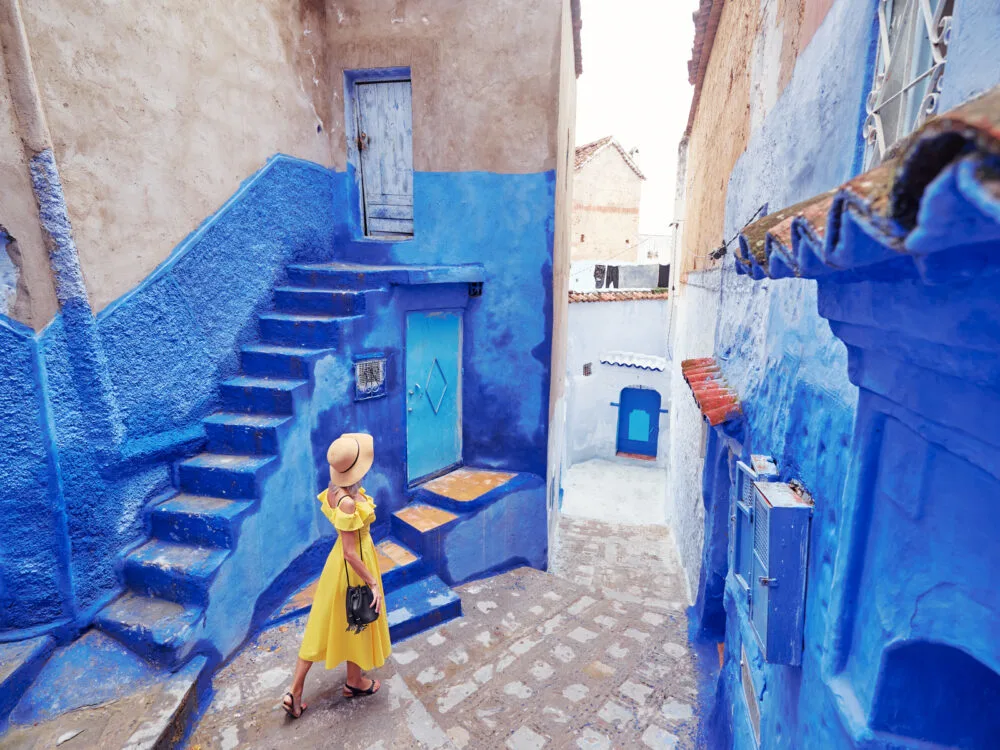
Kudla/Shutterstock
The best time to visit Morocco is during mid-April to May or September to October. These mild-weather months offer warm daytime temperatures and dry conditions that are perfect for sightseeing, beaches, and exploring desert regions that are too hot to enjoy in summer.
With minimal rain and more manageable daily highs from the low 60s to the 90s, Morocco is at its best during mid-April, May, September, and October. You’ll avoid the scorching summer and Ramadan closures while enjoying the best weather this country has to offer.
The hottest Moroccan temperatures are in the Sahara Desert region, so it’s usually at least 10° cooler in the most popular cities to visit during these milder seasons. The mountainous areas are rainier, like Chefchaouen. Areas closer to the desert, like Marrakech, are on the drier side when you see averages like 1-7 rainy days:
- April: 63-87°F; 1-8 rainy days
- May: 69-94°F; 1-5 rainy days
- September: 79-97°F; 1-3 rainy days
- October: 70-86°F; 1-7 rainy days
On Morocco’s coasts and up in the Atlas Mountains, the weather is even more pleasant during these months, averaging 10-20° cooler than the maximum daily highs above.
Venture into the Draa Valley to find a date palm and fig tree oasis of villages, waterfalls (like Tizgui Waterfalls), rugged 4×4 trails, and traditional earthen homes and buildings on your way to the Sahara Desert.
Since daily highs in the desert regions are under 100°F, this is a good time to venture out and explore the Sahara if that’s on your Moroccan bucket list. Explore the sand dunes and ancient landscapes of the barren Sahara Desert on a camel ride.
Erfoud is the gateway city to reach the famous peaked Erg Chebbi dunes in the Moroccan Sahara. You can even arrange for desert camping or glamping if you’re up for an overnight trip.
Make your way to Marrakech while it’s nice and balmy outside to see iconic mosques, like 12th-century Koutoubia and 11th-century Ben Youssef mosques, get lost in a maze of old souks (markets), and stroll the garden oasis surrounding the ruined El Badi and the mosaic-tiled Bahia palaces.
You can stay in a traditional riad, or guesthouse featuring courtyard gardens in the center, with special amenities like rooftop pools overlooking the medina, terraces for dining, and elements of Moroccan tiles and design with plush and comfy rooms.
Using data we’ve averaged from Google Hotels and Skyscanner, you can see that prices aren’t at all prohibitive during the best time to visit. In fact, May is one of the cheapest months of the year to visit with hotel and airfare considered!
- April: $98/night; flights from $689
- May: $81/night; flights from $413
- September: $78/night; flights from $526
- October: $80/night; flights from $603
Some of the annual festivals and events that happen across Morocco can add cultural interest to your trip. Check out some of the following while you’re in the country:
- Sufi Cultural Festival (Apr) in Fez celebrates Sufi music and culture with religious leaders speaking, poetry readings, art, and evening chants and dances
- Rose Festival (May) takes place in the souks of El Kelaa Des Mgouna in the Valley of the Roses as the famous roses here come into full bloom with rose products for sale, music, and refreshments
- Festival of the Brides/Imilchil Moussem (Sept) in the Atlas Mountains brings locals together to seek romance as men and women pair up, declaring “my liver pines for you” (the liver is seen as the center of love, not the heart, in this area)
- Erfoud Date Festival (Oct) in the country’s “Gateway to the Desert” celebrates the arrival of dates from the palm trees, complete with music, dance, and treats centering on sweet and sticky dates
- SIMS Starlight Festival: Agafay Desert (Oct) is a 3-day music and desert experience with the opportunity to stay at a nomad camp under the stars with ethnic music and dance, excursions, and more
While you’ll miss out on some of the awesome music festivals that take place in June and July, you’ll also skip the extremely hot temperatures and enjoy an affordable, milder visit in April, May, September, or October.
Cheapest Time to Visit Morocco
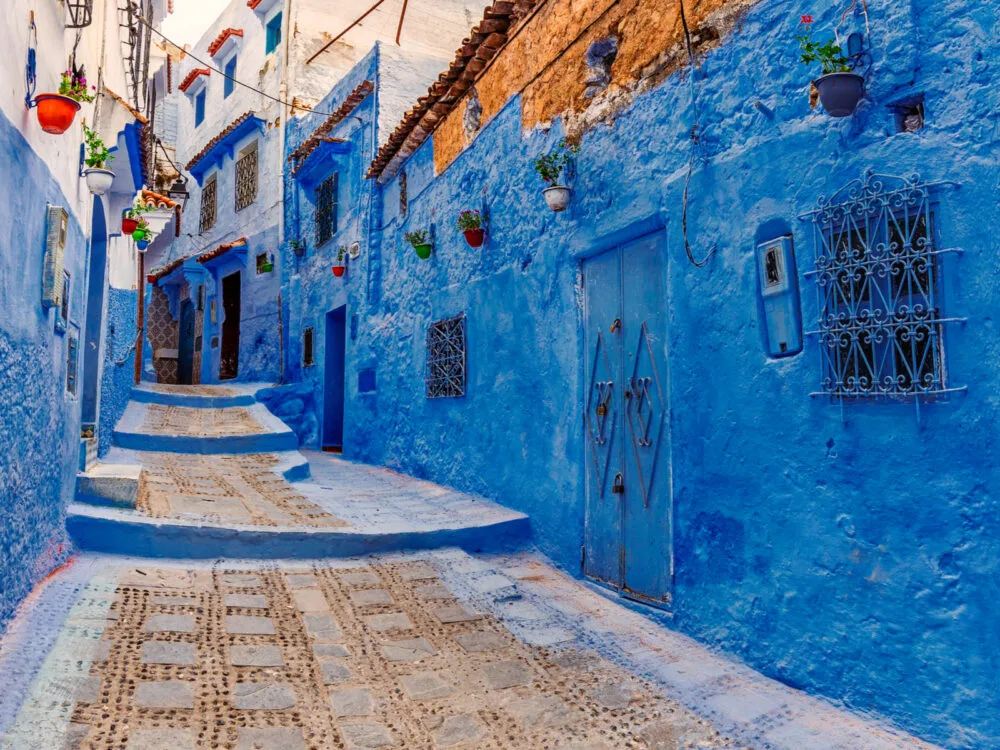
Ruslan Kalnitsky/Shutterstock
May, November, and December are the cheapest months to visit Morocco. Offering the lowest prices on hotels and flights of the year, these mild-to-cool months rake in big savings on a Moroccan trip with fair weather and plenty of things to do.
You can look forward to some really nice, cool weather during these months, especially in November and December. May is much warmer, bordering on hot in areas further south or inland.
- May: 69-94°F; 1-5 rainy days
- November: 62-75°F; 2-8 rainy days
- December: 57-67°F; 1-9 rainy days
With good conditions for spending time outdoors, this is a great time of year to do some hiking in the Rif Mountains (Chefaouen makes a great home base). The Atlas Mountains are snowy in November and December, but the Rif Mountains aren’t as high and will be snow-free.
During May, you can enjoy the crescent-shaped beaches of Agadir, a coastal resort town on the Atlantic Ocean with abundant hotels, restaurants, and shops. Take a cable car trip up the hill overlooking the town brings you to the ruins of Kasbah Agadir.
November and December are great months to visit Marrakech without the heat that appears in late spring and summer. You’ll be able to wander the medina and sightsee without breaking a sweat during these months!
In Fez, check out Borj Nord Arms Museum in a 16th-century fortress. This is a city with rich military history that can be explored at the museum through ancient weapons, shields, ancient crests and coats of arms, and photographs in this museum.
Visit the 1,200 year-old Fez El Bali (medina, or historic town center) souks to pick up inexpensive gourmet foods, like Moroccan olive oil, or handmade slippers, leather goods, and cookery.
Follow the locals to find the best restaurants serving authentic Moroccan cuisine, from slow-roasted, spiced chicken tagine to couscous and grilled seafood.
As the cheapest time to visit Morocco, May and November-December are very affordable. Take a look at the Google Hotels and Skyscanner data below to see how much you can expect to pay for a room and round trip flight from the U.S.:
- May: $81/night; flights from $413 (cheapest fly) 494
- November: $79/night; flights from $465 (cheap hotels, cheaper fly) 544
- December: $79/night; flights from $465 (cheap hotels, cheaper fly) 544
While May, June, and July are the months with the lowest average hotel prices in Morocco, flights are more expensive during June and July. November and December take the other two spots in the top 3 cheapest months to visit Morocco with affordable prices on hotels and airfare.
For a 7-day trip to Morocco, you might pay $980 for your hotel and airfare in May, or $1,020 in November and December — if you can find great deals on your round trip flight.
There’s plenty going on to entertain and immerse you in the Moroccan culture during May, November, and December. Check out events like these:
- Rose Festival (May) takes place in the souks of El Kelaa Des Mgouna in the Valley of the Roses as the famous roses here come into full bloom with rose products for sale, music, and refreshments
- Marrakech International Film Festival (Nov) features screenings and discussions surrounding Arab and African films, their makers, and the actors and actresses that star in them
- Tan Tan Moussem (Dec) is a tribal gathering bringing people together from southwestern Morocco and North Africa for storytelling, traditional dance, camel races, and more
With the chance to see Morocco’s greener areas in full bloom with roses, the best prices of the year on flights and hotels, and plenty of options for outdoor activities and sightseeing, this is a great time of year to visit the country.
Least Busy Time to Visit Morocco
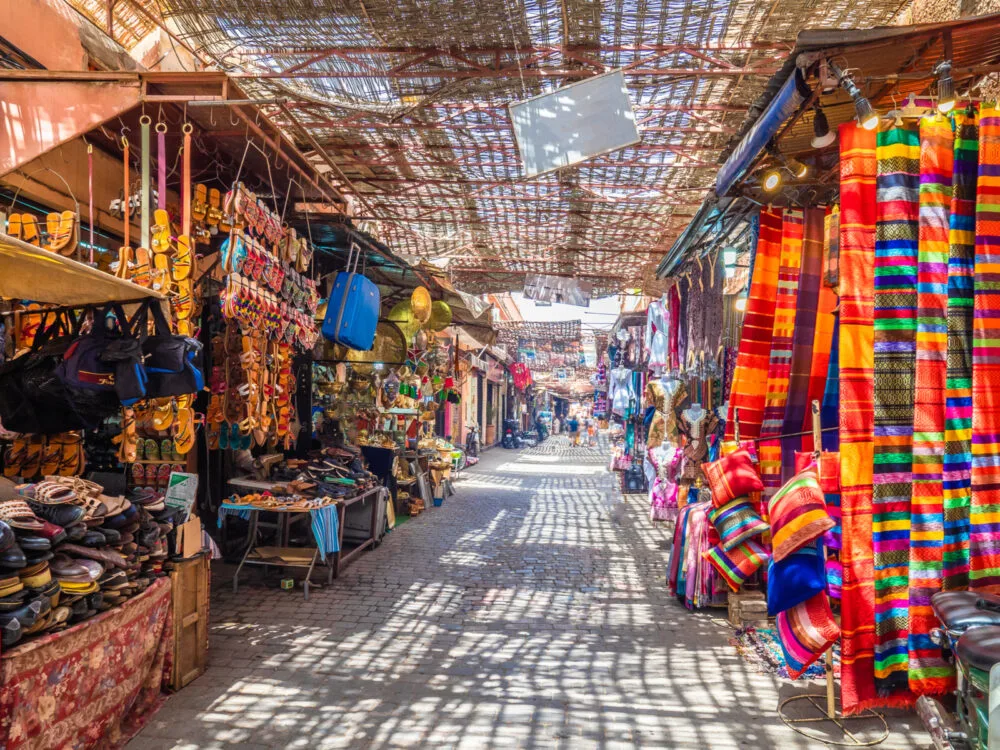
Balate Dorin/Shutterstock
May through July is the least busy time to visit Morocco. Scorching temperatures in areas closer to the desert (like Marrakech) and bone-dry conditions keep normal tourism numbers at bay as the summer kicks off.
With anywhere from zero to 5 rainy days each month (almost no rain in June and July), Morocco is incredibly dry and warm to sweltering during the summer months. May offers a less-extreme time to visit during this less-busy period:
- May: 69-94°F; 1-5 rainy days
- June: 76-102°F; 0-1 rainy day
- July: 83-107°F; 0-1 rainy day
While daily high temperatures surpass 100°F in the desert and southern Morocco, most of the popular destinations are much cooler during the summer. Marrakech is hot, between 83–98°F, this time of year, but coastal Agadir, Asilah, and Taghazout offer a blissful reprieve from the heat with highs in the mid-70s and 80s.
It’s a good time to explore the Blue Village of Chefchaouen high in the Rif Mountains, where it’s cooler this time of year. White-washed and blue stucco buildings with Moroccan tiles wash the medina in an azure sea of color that’s unlike anything else you’ll see in Morocco.
Look for the tapestries and carpets hung in Chefchaouen alleys and the impressive Kasbah in the heart of town. Just outside the city, you can swim in spring-fed waterfalls in the mountains to cool off during the peak summer months!
Head to the beaches of Asilah, Taghzout, or Agadir to enjoy ocean breezes and warm weather that’s easily remedied with a dip in the Mediterranean Sea or Atlantic Ocean when the sun’s at its strongest.
Visit Toubkal National Park in the High Atlas Mountains for a cooler climate during the warm summer months. It’s a prime spot for climbing and hiking, but the presence of eagles and falcons along with gorge, cliff, and valley views make it a beautiful place to visit.
Head to the capital, Rabat, to see the Mohamed VI Institution of Modern and Contemporary Art to discover historic and modern artwork created in Morocco (and escape the heat while you’re at it).
In Rabat, the famous 12th-century Hassan Tower looms over the city and mosque ruins nearby, and Rabat Beach sits on the Atlantic for nice coastal views and beach days when you’re desperate to cool off.
Prices during the least busy time to visit are some of the best of the year. Using data from Google Hotels and Skyscanner, we found that May is the overall cheapest month to visit (flights and hotels considered), while June and July offer the lowest average hotel prices of the year:
- May: $81/night; flights from $413
- June: $76/night; flights from $506
- July: $76/night; flights from $621
If you’re planning a 7-day vacation in Morocco this time of year, you could expect to spend around $980 in May, $1,040 in June, and $1,153 in July if you’re able to score the best airfare (always book in advance and use flight price trackers to do this).
As far as festivals and events, May-July is a great time to experience the culture and traditions of Morocco. You’ll find the most music festivals of the year during this time:
- Jazzablanca (early Jun) is a 2-day outdoor jazz festival in Casablanca, where thousands of people come to hear local and international jazz artists and bands perform on 4 stages
- Fez Festival of Sacred World Music (early Jun) brings artists and musicians from different faiths and backgrounds together to perform during this 10-day event in Fez
- Otium Festival (mid-Jun) in lovely Taghazout Bay brings electronic music to the natural beauty of the mountain-backed beaches here, lighting up the stage with big performances that draw thousands
- Gnaoua and World Music Festival (late Jun) in Essaouira brings traditional Gnawa/Gnaoua music from the region to the stage along with world music bands over 2 days in June
- Mawazine (late Jun) in Rabat is one of the world’s biggest music festivals with a star-studded lineup across genres, including traditional Moroccan music, on multiple stages with hundreds of thousands in attendance
- Timitar Festival (Jul) in coastal Agadir is filled with sounds of traditional Amazigh music of the Berber people, food, dancing, and amazing coastal views
- International Cultural Festival (Jul) in Asilah spans most of the month, transforming the streets of the medina into open-air galleries where art, literature, film, music, and dance take over with freshly-painted murals by local artists
- National Festival of Popular Arts (Jul) in Marrakech showcases traditional music, dance, and art across Morocco’s diverse regions with fire-breathers, fortune tellers, snake charmers, and acrobats making it a memorable experience
If you can beat the heat by heading to the coasts, mountains, or indoor attractions across Morocco, May through July are great months to visit with smaller crowds, affordable prices, and tons of things to do.
Worst Time to Visit Morocco
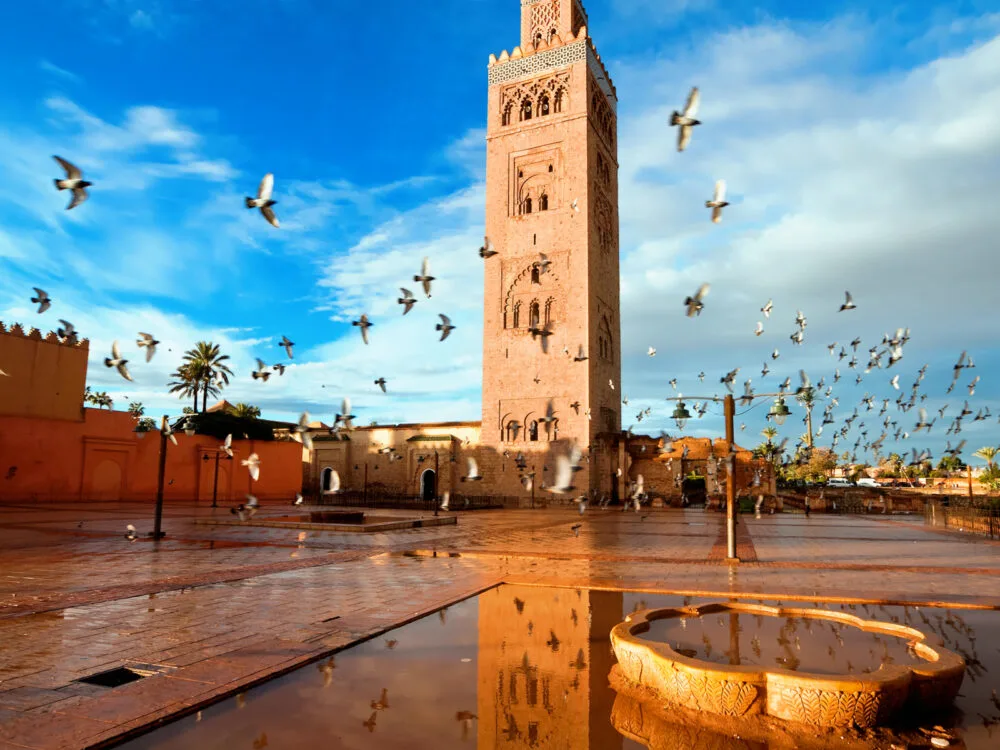
Migel/Shutterstock
March, early April, and July are the worst times to visit Morocco. March and early April mark holy Ramadan, when many local shops, restaurants, and businesses close as Muslims practice daytime fasting and prayer. July is the hottest month of the year.
The biggest issue with visiting Morocco during Ramadan is the closures that happen around the country. Most businesses, including restaurants, markets, and stores, close down to honor the holy month.
That makes it harder to get food during the day while you’re out and about. Some visitors have remarked that they were encouraged not to snack or eat themselves, even when not participating Ramadan. For these reasons, Ramadan is one of the worst times to visit Morocco.
That’s a shame, because outside of these restrictions, March and early April are genuinely amazing times to visit Morocco with excellent weather. July, though, is very hot in some areas and another of the worst months to visit the country.
- March: 60-79°F; 1-7 rainy days
- April: 63-87°F; 1-8 rainy days
- July: 83-107°F; 0-1 rainy day
While coastal and mountainous parts of Morocco will be much cooler than the average desert highs of 107°F in July, you’ll still be dealing with temperatures in the 80s or 90s this time of year. That can drain the fun right out of your Moroccan adventure!
Pricing is another aspect of what makes these months less enjoyable for a visit. March is pretty affordable, but April is the most expensive month of the year to go to Morocco. July is considerably cheaper, but airfare is expensive.
Take a look at data from Google Hotels and Skyscanner below to see what you can expect to pay for your trip to Morocco during the worst months:
- March: $86/night; flights from $525
- April: $98/night; flights from $689
- July: $76/night; flights from $621
While average hotel prices under $100/night don’t sound bad, the airfare can make visits during either of these months prohibitively expensive for budget-conscious travelers.
Ramadan and the Sufi Cultural Festival are two major events in April. One silver lining for visiting in July is the number of events and music/cultural festivals that take place this month, like the Timitar Festival in Agadir, the International Cultural Festival in Asilah, and the National Festival of Popular Arts in Marrakech.
With dry conditions in all three months, the daily high temperature averages make it clear that March or April would be preferable to July if you absolutely must visit during one of these months. April is preferable if you can visit after Ramadan ends early in the month.
Morocco by Month: What to Expect
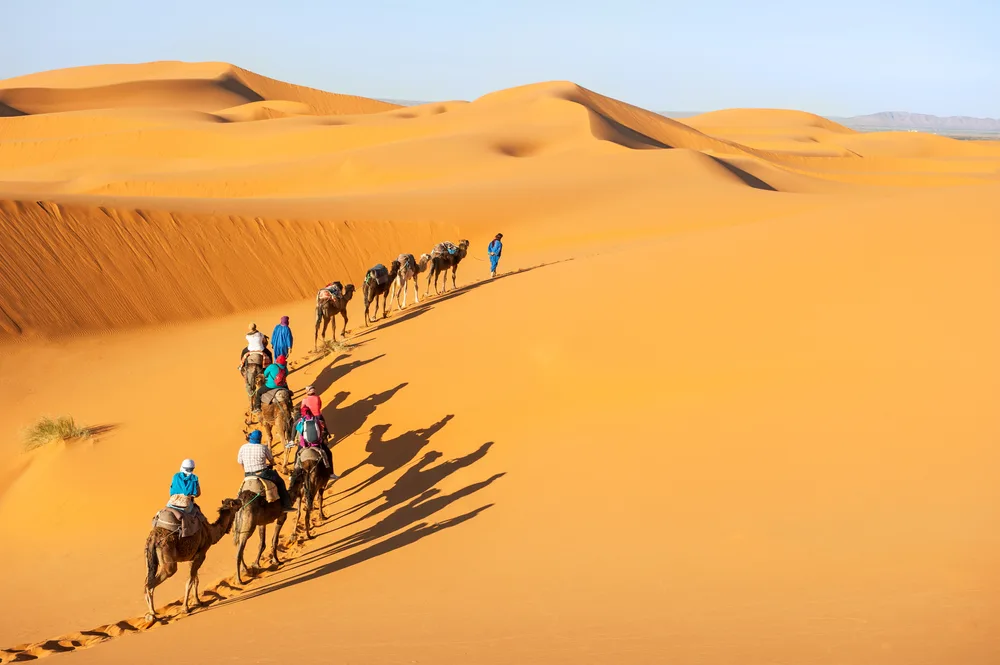
Vixit/Shutterstock
If you haven’t settled on your travel dates yet, take a look at weather, pricing, and general info about each month of the year in Morocco to make the most informed choice.
January
Morocco’s coolest month of the year with highs from 55-66°F and 1-7 days of rain, January sees the arrival of blossoms and flowers. It’s a great month to visit Marrakech, Fez, or head up into the mountains to Tafraoute for the Almond Blossom Festival. You’ll pay around $82/night for a hotel, while round trip flights start around $600.
February
Still cool and mild with 1-7 days of rain, February highs range from 56-72°F and conditions are really nice for visiting the areas that will be hot in summer — the Sahara Desert, Agafay Desert, Marrakech, etc. You’ll pay roughly $84/night for your hotel and upwards of $652 for round trip flights this month.
March
March sees the arrival of spring-like temperatures with highs from 60-79°F and 1-7 rainy days. As temperatures warm up inland, head to the coasts or mountains for cooler weather. Ramadan starts early this month and lasts though April, closing businesses and eateries during the day. You’ll pay around $86/night for a hotel and $525+ for flights.
April
Ramadan wraps up during the first week or so of April, bringing lots of tourists to the country as businesses open back up. Hotels are higher in price around $98/night, but flights are where it hurts (starting at $690 round trip). With highs between 63-87°F and 1-8 days of rain, April is nice and balmy to warm with the Sufi Cultural Festival happening in Fez this month.
May
As the cheapest month to visit Morocco overall, May sees low hotel prices ($81/night on average), low airfare (starting at $413 round trip), and great weather that trends mild to warm with highs between 69-94°F. With 1-5 rainy days and the famous Rose Festival in the Valley of the Roses early this month, it’s a cheap and less-busy time to visit.
June
June’s daily highs rise to 76-102°F, on the hotter end near the desert and Marrakech. With almost no rain, it’s a great month for smaller crowds and festivals like Casablanca’s Jazzablanca, Fez’ Festival of World Music, Taghazout’s Otium Festival, and Rabat’s Mawazine. Hotels cost around $76/night and flights are priced around $506 and up for round trip airfare.
July
July is another less-busy month, bringing daily highs between 83°F and 107°F with almost no rain. Hotels are around $76/night and round trip flights starting at $620. It’s one of the worst months to visit with the heat. The Timitar Festival, International Cultural Festival, and National Festival of Popular Arts happen this month.
August
August sees highs begin to decrease (80-105°F) and still no rain for most of the country. With flights starting around $680 round trip and hotels at $83/night, it’s not a bad time to visit Morocco if you can visit the beaches or mountainous regions instead of the desert and Marrakech (hottest areas).
September
September brings more spring-like weather with highs between 79-97°F and 1-3 rainy days. It’s warm in areas, but mild in others and nice for outdoor activities, sightseeing around old medinas, and exploring historic mosques. Hotels cost around $78/night and flights start at $530 round trip.
October
October can be a great month to visit with bearable highs between 70°F and 86°F, 1-7 rainy days, and affordable prices on hotels and flights ($80/night and flights from $603 round trip). Check out the Erfoud Date Festival for sweet treats from the palms, or venture into the Agafay Desert for Starlight excursion with 3 days of nomad camping and concerts.
November
As one of the cheapest months to visit, November’s low hotel prices ($79/night on average) and round trip airfare (starting at $465) make it more affordable. Highs range from 62-75°F, so the weather is mild and enjoyable in areas that are scorching in the summer, like Marrakech and Fez. Check out the Marrakech International Film Festival this month.
December
Another of the cheapest months to visit, December’s average hotel prices are around $79/night with round trip airfare starting at $465. Highs are cool and mild, between 57-67°F, and there can be up to 9 rainy days in parts of the country. This can be a busy time to visit, but well worth it for the savings.
Frequently Asked Questions
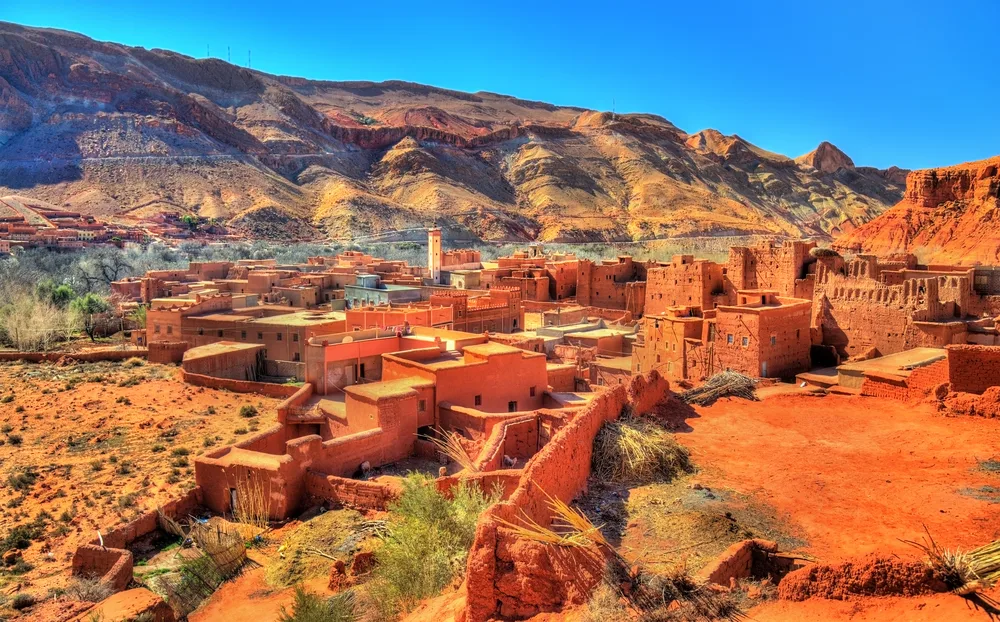
Leonid Andronov/Shutterstock
Still have some questions about figuring out the perfect time to visit Morocco? Take a look at the most frequently asked questions from travelers below to learn more.
What month is best to go to Morocco?
May is the best month to go to Morocco overall. It’s the cheapest month to fly to Morocco (round trip airfare starts at $413) with really affordable hotel prices around $81/night. May’s weather is mild to warm with highs between 69°F and 84°F and dry with 1-5 rainy days. Events like the Rose Festival in the Valley of the Roses take place in May.
What is the cheapest month to visit Morocco?
May is the cheapest month to visit Morocco, while November and December are similarly affordable with cooler weather. In May, you can expect to pay around $980+ for a 7-day stay with round trip flight. The price is closer to $1,020 in November and December, making these 3 months the cheapest times to visit Morocco.
What is the best time of year in Marrakech?
Spring and fall are the best times of year in Marrakech. While winter offers the coolest temperatures, rain can get in the way of exploring the souks, palaces, mosques, and maze-like streets of the medina. Spring and fall offer mild weather in the 70s and 80s and very little rain for the perfect Marrakech visit.
What is the rainy season in Morocco?
The “rainy season” in Morocco runs from September to April or November to March in coastal areas. Morocco doesn’t experience heavy rains during this period, but can see as much as 9 rainy days per month at the peak in winter (December to February). The mountains and coasts are rainier than the desert regions.
How many days do you need in Morocco?
You need at least 7 days in Morocco to enjoy the most immersive experience in this fascinating country. Spending 7 days gives you enough time to explore 1-2 cities and check out beautiful regions like the Draa Valley, beaches at Atlantic or Mediterranean coastal towns, historic villages in the Atlas Mountains, and shop at bustling souks in the medinas of old cities.
So, What’s the Best Time to Visit Morocco?
| 👍 Best Time to Visit | Mid April-May & September-October |
| 💲 Cheapest Time to Visit | May, November-December |
| 🗓️ Least Busy Time to Visit | May-July |
| 👎 Worst Time to Visit | March-early April & July |
The best time to visit Morocco is from mid-April to May and September to October. These mild-to-warm months offer the best weather, events, and affordable pricing for a stellar Moroccan trip.
May, November, and December are the cheapest months to visit with the lowest average hotel prices and round trip airfare costs. You’ll save a lot and enjoy the mild weather in November-December with warmer, drier conditions in May.
Wait until May, June, and July if you’re looking for the least busy time to visit. Fewer tourists are in the country this time of year and you’ll appreciate smaller crowds and better availability for hotels, restaurants, and flights.
Try to avoid visiting during Ramadan, typically March to early April, and in July, which is the hottest (though one of the least busy) months of the year.
You know some of the wonders and sights that await you in historic Morocco — from beautiful beaches and blue villages in the mountains to tiled royal palaces and labyrinthian souks in ancient medinas, this is a place you’ll enjoy so much more when you go at the right time of year.



